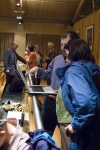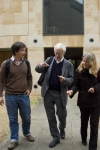 |
 |
|||||||||||||
|
|||||||||||||
|
|||||||||||||
“I know it is painful — nobody expected it to be fun,” Ties Behnke, standing in front of a detector audience in a lecture hall at Cambridge University, summed up the at times rather heated discussions at the ILD meeting two weeks ago. “But we are making progress and it actually turned out to be fun!” The scientists working on the International Large Detector concept ILD had met for the second time this year to discuss the set-up of their future masterpiece. The ILD group formed about a year ago from the former GLD and LDC detector concept groups. Both concepts had their plans for trackers, calorimeters and the detector set-up as a whole. “This was actually a birthday of ILD. We have been working on two different detector concepts up to this meeting. Now, we have a single concept to work on,” said Hitoshi Yamamoto. They have also agreed to have a single software framework managed jointly. The deadline for submission of a common Letter of Intent (LOI) is in March 2009, and many parameters have to be set before work can start in earnest. The challenge for ILD was to define a common set of parameters, trying to find the optimum solution for each subsystem, based on the work done in the two groups. To do so the scientists ran extensive studies over the last couple of months with the goal to define a set of common parameters based on solid scientific results. In Cambridge, all the different groups met face to face, exchanged results, discussed conclusions and worked towards the definition of a common reference detector. The presented results were based on a first round of about 15 million fully simulated and reconstructed events. In parallel R&D is continuing in different R&D collaborations around the world, and many new results on for example technologies or detector performance were available. These results, in addition to the results from the simulation studies, needed to be included in the decision process. In many cases final decisions were not possible however, and the ILD group takes this into account by defining a rather flexible 'reference detector', which leaves room for future technological developments, allows for different options and even allows to swap some subdetectors around, depending on the results from the R&D. “We have many viable options, but in many cases we can't make a choice yet,” explains meeting organiser Mark Thomson from Cambridge University. Nevertheless for the studies needed to write the LOI the ILD scientists have to base themselves on a well-defined reference detector for which they can prepare large-scale event samples. The Cambrige meeting saw quite some progress in defining this. The main parameters — the B-field, the detector's overall size, the conceptual subdetector layout — were actually finished during the meeting. Special task forces received more detailed work to be sorted out over the next few weeks. “We are not excluding any technologies — we are using these parameters as our baseline,” stresses Behnke. Simulations are now starting in time to be ready for the first draft of the LOI by early 2009. -- Barbara Warmbein |
|||||||||||||
| © International Linear Collider |

